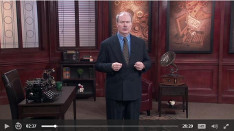Understanding the Inventions That Changed the World is a video course from The Great Courses Plus, with lectures by Professor Bernard W. Carlson. Carlson includes many visuals of artifacts, photos, computer simulations, and other graphics that illustrate what he is saying, so this is a very visual course.
This course certainly isn’t traditional, but it should serve well as a one-semester history and/or science course for one semester at the high school level. There are 36 video lectures, each running about 30 minutes. For each lecture, there are two or three questions for students to answer. Questions require short-essay answers, so they will take some time to complete. For example, a question on page 43 asks, “How does the arch overcome the limitations of stone as a building material, and how did it allow the Romans to create huge structures?”
With both videos and questions, students might spend something like 36 to 40 hours. To flesh out a semester course to 60 hours, you might add a requirement for some additional reading, research, and/or writing. You could assign either a half credit for science or a quarter credit each for history and science.
The companion guidebook, a PDF document that comes with the course at no extra cost, is essentially the script for the lectures with only minor differences. The guidebook is also where you will find the student questions as well as suggested reading. The suggested reading might prompt ideas for further reading and research.
This course is fascinating, highlighting inventions from throughout history and around the world. Examples of some of the topics covered are the potter’s wheel, metallurgy, the galley, coins, the alphabet, Roman arches, clocks, pagodas, cathedrals, paper and printing, gunpowder, cannons, guns, telescopes and microscopes, steam engines, canals, railroads, water and sewer systems, batteries, telephones, electric light and power, motion pictures, steel, glass, plastics, aviation, radio and television, nuclear power, electronics and chips, satellites, cell phones, personal computing, genetic engineering, and the internet.
There’s even a lecture on “Beer, Wine, and Distilled Spirits,” in which Carlson shows how the creation of alcoholic beverages helped preserve and make use of crops. This introduction for the lecture should give you a good sense of how Carlson approaches these inventions from historical, scientific, and cultural perspectives.
Not only are beer, wine, and distilled spirits something we still enjoy, they are also great examples of people learning how to deliberately manipulate chemical and biological processes in order to get a particular outcome—i.e., an alcoholic beverage. In this lecture, you will learn that people have been deliberately manipulating these organic processes for thousands of years, beginning even before the civilizations of ancient Mesopotamia and Egypt. Beer, wine, and liquor are great inventions that remind us how humans use things to shape social order and convey cultural meanings and that technology is not just about the inorganic but also the organic. (p. 17)
While some younger students will be able to understand many of the lectures, I think the course as a whole will be best for juniors and seniors (as well as adults) since it assumes a background of historical and scientific understanding that might be lacking in younger students.
The course is available for purchase through The Great Courses (click here) or you can access it through a subscription to Wondrium.









